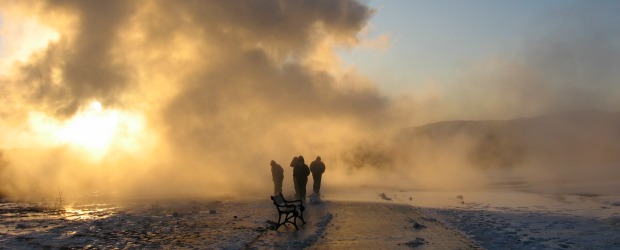You have no items in your cart. Want to get some nice things?
Go shopping
“The writer in Iceland is God,” says Hallgrimur Helgason, an Icelandic author speaking from the small screen affixed to the back of the airplane seat in front of mine. I am flying to Reykjavik, and passing the time by watching the short documentaries on the country presented by Iceland Air. I’ve been leafing through a magazine as well, only half paying attention. But now, as a writer myself and a traveller who sometimes picks destinations based on their literary history, I am transfixed.
“This is because of the literary tradition we have from the Sagas,” Helgason says. “Iceland is sort of a writer’s paradise.”
In my bag, I’ve got a copy of Jar City, a murder mystery by Arnaldur Indridason that is set in the capital city of Reykjavik. It was recommended to me by the clerk at an international bookstore I like to browse. But I’ve never read an Icelandic author before. This trip was inspired more by an interest in natural phenomena—the Blue Lagoon, the Aurora Borealis—than by literature.
I flip to the section on history in my guidebook, and as I skim through the country’s Viking origins to the present day, a sentence leaps out at me: Iceland publishes more books per capita than any other nation in the world. Suddenly, my expectations for this trip have shifted. As I fish Jar City out of my bag, I know I will go in search of the literary treasures of this tiny island nation.
Early Icelandic literature can be divided into three kinds: the Eddas, Skaldic poetry, and the most famous branch—the Sagas. The Eddas were mostly mythological stories, while Skaldic poetry (composed by poets known as skalds) was composed to honour nobles and kings. The Sagas, by contrast, relate historic events, sometimes dressed up with fantastic or romantic elements. In Iceland, they are regarded as prose histories of the tenth- and eleventh-century Norse and Celtic inhabitants of the country. The style of the Sagas will be familiar to anyone who has read Beowulf—with plain prose that recounts the adventures of a central hero renowned for his bravery. The Sagas typically place emphasis on situating the individual within his noble lineage and pinpointing his inherited traits. So begins Egils Saga, believed to have been written by 13th-century poet and historian Snorri Sturluson:
There was a man named Ulf, son of Bjalf, and Hallbera, daughter of Ulf the fearless; she was sister of Hallbjorn Half-giant in Hrafnista, and he the father of Kettle Hæing. Ulf was a man so tall and strong that none could match him, and in his youth he roved the seas…
The family trees can get a little complex. But that doesn’t keep people from reading them—evidently nearly every household owns a copy of the Sagas. I decide I’ll head to 15 Hverfisgotu Street, near Reykjavik’s waterfront, which I’m told is one of the best places to learn about Icelandic literary tradition. The Culture House has an exhibit that explores the perspective of Northern Europeans during the time period of the Sagas, which included the Viking Expansion, the settlement of Iceland and the other Atlantic islands, and the transition from paganism to Christianity. But most impressive are the actual medieval manuscripts on display. Scribes used ink made of berries and herbs to write on sheets of vellum prepared from calf’s skin. Dimly lit rooms house these ancient books, opened to colourful illuminated illustrations of warriors and neatly penned lines of text.
I have heard that nearly every Icelander writes poetry, and it is not hard to imagine that this is true in the cosy coffee houses that line the streets of downtown Reykjavik, filled with blonde clientele bent over notebooks or tapping at laptop keyboards. But as I pass an afternoon soaking in a public thermal pool, known as a “hot pot,” amongst locals who come to bathe regularly in the mineral-rich waters, it becomes clear that the oral tradition is also alive and well. The tourists sit quietly and close their eyes, while Icelanders chat animatedly, telling stories in a language that sounds vaguely Germanic, which it is. A common saying goes that the hot pot is to Icelanders as the pub is to Brits or the café to the French.
I look for evidence of a contemporary literary community on the city’s newsstands, where I find a dynamic glossy called the Iceland Review, written in English. There is also the Reykjavik Grapevine, a monthly English-language newspaper. At the weekend, the city’s Kolaportid flea market near the Old Harbour seems like a promising place to look for evidence of book trade, and sure enough, I find a charming corner occupied by wooden bookcases and crates and tables full of paperbacks, some of them American literature in translation, many of them in the original English, and the majority Icelandic books published in Icelandic. My favourite find is a hardcover children’s book called Litlr Isbjorn (“Little Polar Bear”) with careful illustrations of a small white bear and his adventures in the Icelandic wilderness. The bookseller mentions casually that one in ten Icelanders is a published writer.
Street signs lead me next to the National Library, a modern red and white building that stands past frozen Tjornin pond near a traffic circle on Armgrimsgata Street. Its collection contains every book ever printed in Iceland, along with antique maps of the country, and Bibles in more than 12,000 languages. Here too is the Nobel Prize acceptance speech given by Halldor Laxness, the first Icelandic author to win the Prize in Literature in 1955. It reads, in part:
[As I accept this honour,] I am thinking… of that community of one hundred and fifty thousand men and women who form the book-loving nation that we Icelanders are. From the very first, my countrymen have followed my literary career, now criticizing, now praising my work, but hardly ever letting a single word be buried in indifference. Like a sensitive instrument that records every sound, they have reacted with pleasure or displeasure to every word I have written. It is a great good fortune for an author to be born into a nation so steeped in centuries of poetry and literary tradition.
It seems to me—as I read through Laxness’ remarks—that no writer could ask for more. And as I find myself seeing the city of Reykjavik through the eyes of Arnaldur Indridason, author of the Icelandic thriller I’ve been reading, it is hard to imagine traveling to this place without embracing its love for story. There is something about Iceland—perhaps its candlelit corners, or the colour of the sky in winter, when the sun rises at mid-morning—that simply begs to be written.

About Andrea Calabretta
Andrea Calabretta is a writer and editor based in Philadelphia. She is currently at work on a book about her experiences in Tunisia during the so-called Arab Spring.



